Where Is The Famous "Mona Lisa" Painting Housed?
The item that unlocks the Mona Lisa
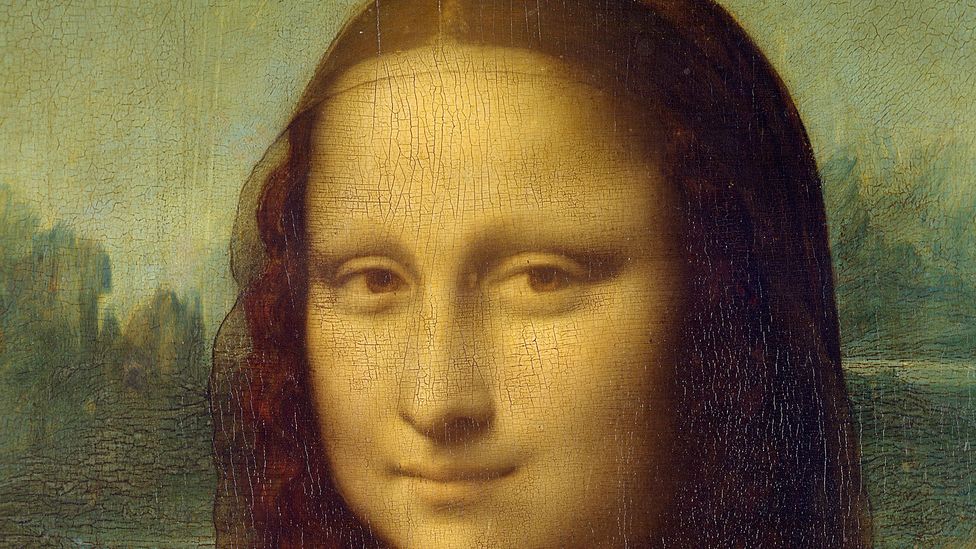
The 1503 painting by Leonardo da Vinci is the earth's most famous slice of art. Kelly Grovier explores an disregarded object that offers a different perspective on the masterpiece.
Due south
Some things are so obvious you never really notice them. Take, for instance, the way the white space between the "E" and the "ten" in the FedEx logo forms a big white arrow pointing forward. We've seen the sign whizz past u.s. endless times without ever clocking its subliminal point. Some other ubiquitous cultural epitome is the Mona Lisa. Leonardo da Vinci'south inexhaustible portrait of Lisa del Giocondo, the 24-year-former female parent of v and married woman of a wealthy Florentine silk merchant who sat for the High Renaissance master in 1503, is doubtless the most famous work of art in the globe. Even so how many of us have ever consciously noted the object in the painting that is closer to us than any other – the chair on which the mysterious woman sits? Never mind that the piece of article of furniture is the only thing that Leonardo'south sitter grips in her hand (she's literally pointing at it with every finger she has), the chair must surely be the single most neglected aspect of the otherwise over-stared-at icon. Hiding in manifestly sight, it may as well exist the arrow that points the way to the work's deepest meanings.
More than like this:
- The fresco with multiple identities
- The underground toilet humour in a Titian painting
- The tragedy of fine art's greatest supermodel
For centuries, our attention has largely been focused elsewhere in the small (77 x 53cm/xxx 10 21in) oil-on-poplar console, which Da Vinci never fully finished and is thought to have connected to tinker with obsessively until his death in 1519 – equally if the painting's countless emergence were the work itself. A preoccupation principally with Mona Lisa's inscrutable smile is nigh as old as the painting, and dates back at least to the reaction of the legendary Renaissance writer and historian Giorgio Vasari, who was built-in a few years later on Da Vinci began piece of work on the likeness. "The oral cavity with its opening and with its ends united past the red of the lips to the mankind-tints of the face," Vasari observed in his celebrated Lives of the Most Splendid Painters, Sculptors, and Architects, "seemed, in truth, to be not colours simply flesh. In the pit of the throat, if one gazed upon it intently, could be seen the beating of the pulse." He concluded: "In this work of Leonardo, there was a smile so pleasing, that it was a thing more divine than human to behold, and information technology was held to be something marvellous, in that it was not other than alive."
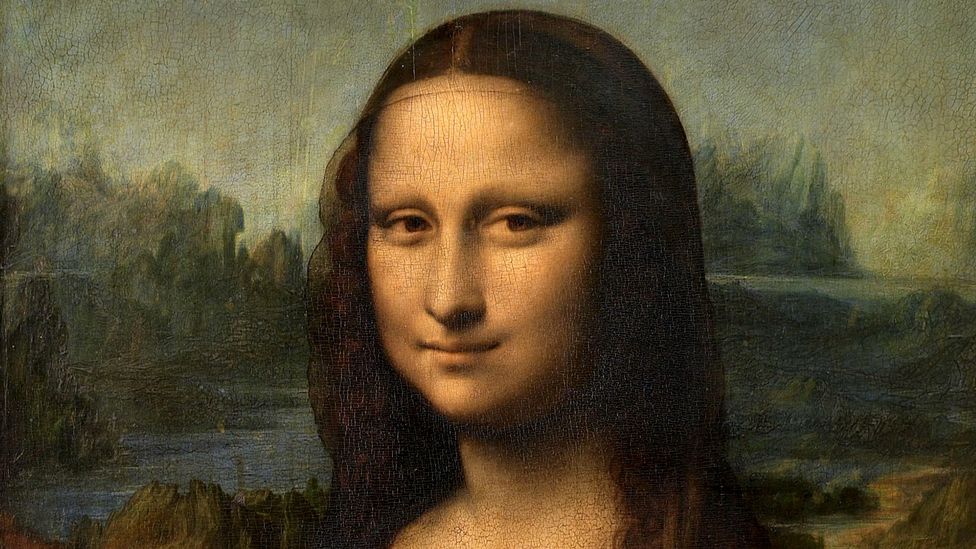
Many scholars accept been fascinated by the mystery of Mona Lisa's smile (Credit: Alamy)
The mesmerising mystery of Mona Lisa's smile and how Leonardo magically leveraged it into creating "a affair more divine than man" and yet "not other than alive" would bear witness likewise intense for many to bear. The 19th-Century French art critic Alfred Dumesnil confessed to finding the painting's paradox utterly paralysing. In 1854 he asserted that the subject's "smile is full of attraction, just information technology is the treacherous attraction of a ill soul that renders sickness. This so soft a look, simply avid like the sea, devours". If legend is to be believed, the "treacherous attraction" of Mona Lisa'south irresolvable smirk consumed likewise the soul of an aspiring French artist past the proper name of Luc Maspero. According to pop myth, Maspero, who allegedly ended his days past leaping from the window of his Paris hotel room, was driven to destructive distraction past the mute whispers of Mona Lisa'due south engrossingly gladsome lips. "For years I accept grappled desperately with her smiling," he is said to have written in the note he left behind. "I prefer to die."
Not anybody, nevertheless, has been content to locate the heart of Mona Lisa's magnetising mystique in her enigmatic grin. The Victorian writer Walter Pater believed it was the "delicacy" with which her hands and eyelids are rendered that transfix and hypnotise us into believing that the piece of work possesses preternatural power. "Nosotros all know the face and hands of the figure," he observed in an article on Da Vinci in 1869, "in that circumvolve of fantastic rocks, as in some faint low-cal under sea". Pater proceeds to meditate on the Mona Lisa in such a singularly intense style that in 1936 the Irish poet William Butler Yeats plant himself compelled to seize a judgement from Pater'due south description, interruption information technology upward into gratis-poesy lines, and install them as the opening poem in the Oxford Book of Modernistic Verse, which Yeats was so compiling. The passage that Yeats couldn't help co-opting begins: "She is older than the rocks amid which she sits; similar the vampire, she has been dead many times, and learned the secrets of the grave; and has been a diver in deep seas, and keeps their fallen day well-nigh her; and trafficked for strange webs with Eastern merchants, and, equally Leda, was the mother of Helen of Troy, and, as Saint Anne, the mother of Mary; and all this has been to her merely equally the sound of lyres and flutes." The portrait "lives", Pater concludes, "only in the delicacy with which it has moulded the changing lineaments, and tinged the eyelids and the hands".
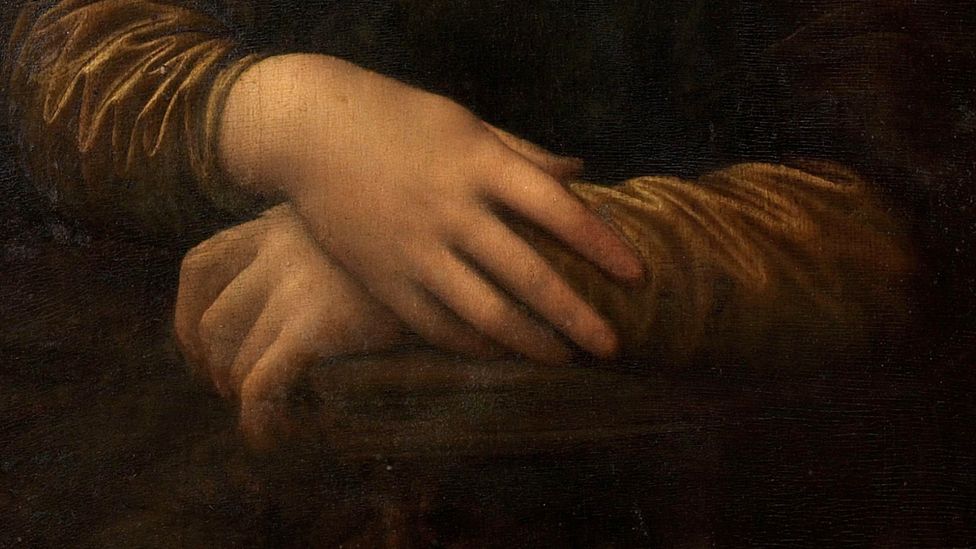
Some viewers are as transfixed past Mona Lisa's easily equally past her face up (Credit: Alamy)
Pater'southward description all the same astounds. Different Dumesnil and the doomed Maspero before him, Pater sees past the seductive snare of the portrait'southward smile to a larger vitality that percolates every bit if from deep below the surface. Contending that the painting depicts a effigy suspended in ceaseless shuttle between the here-and-now and some otherworldly realm that lies beyond, Pater pinpoints the mystical essence of the panel'southward perennial appeal: its surreal sense of eternal flux. Like Vasari, Pater bears witness to a animate and pulsing presence – "changing lineaments" – that transcends the inert materiality of the portrait's making. Key to the forcefulness of Pater's language is an insistence on aquatic imagery that reinforces the fluidity of the sitter's elusive cocky ("faint low-cal under the body of water", "a diver in deep seas", and "trafficked… with Eastern merchants"), as if Mona Lisa were an ever-flowing fountain of living water – an interminable ripple in the endless eddies of time.
Peradventure she is. In that location is reason to think that such a reading, which sees the sitter as a shape-shifting spring of eternal resurgence, is precisely what Leonardo intended. Flanked on either side by bodies of flowing water that the creative person has ingeniously positioned in such a fashion as to suggest that they are aspects of his sitter's very existence, Da Vinci'due south bailiwick has a strangely submarine quality to her that is accentuated by the algae green dress she wears – an amphibious second skin that has only grown murkier and darker with time. Pivoting her stare slightly to her left to see ours, Mona Lisa is poised upon not only any old bench or stool, only a deep-seated perch known popularly every bit a pozzetto chair. Pregnant "little well", the pozzetto introduces a subtle symbolism into the narrative that is as revealing as it is unexpected.
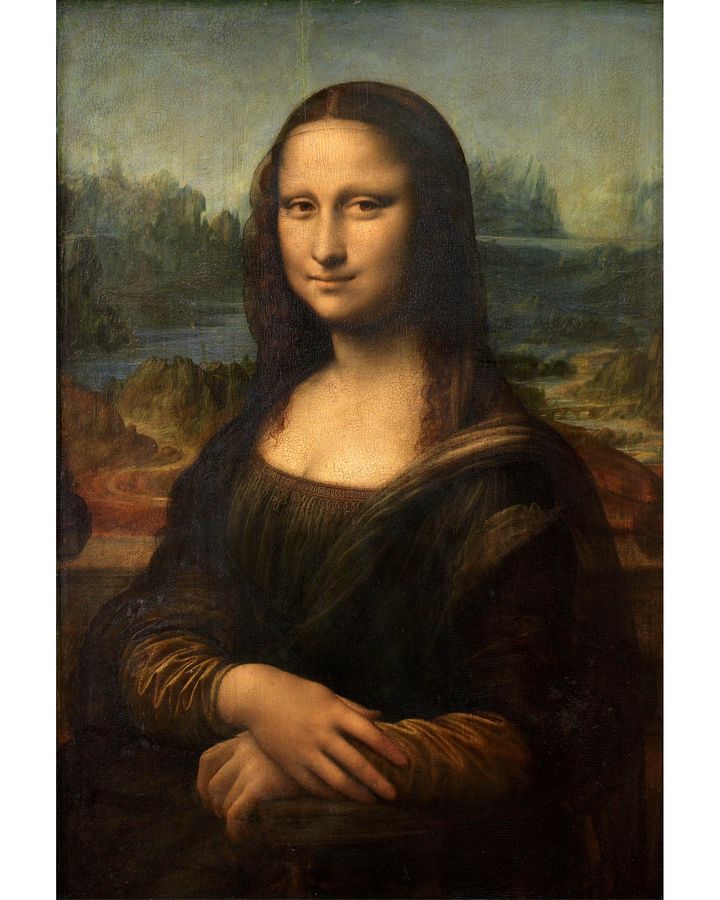
Past placing Mona Lisa on a 'little well', surrounded by h2o, Da Vinci could exist drawing on earlier spiritual connections with springs (Credit: Alamy)
All of a sudden, the waters we run into meandering with a mazy motion behind Mona Lisa (whether belonging to an actual mural, such equally the valley of the Italian River Arno, as some historians believe, or entirely imaginary, equally others debate) are no longer distant and disconnected from the sitter, simply are an essential resource that sustain her existence. They literally flow into her. By situating Mona Lisa inside a "little well", Da Vinci transforms her into an always-fluctuating dimension of the physical universe she occupies. Fine art historian and leading Da Vinci expert Martin Kemp has also detected a cardinal connection between Mona Lisa'south depiction and the geology of the world she inhabits. "The artist was not literally portraying the prehistoric or future Arno," Kemp asserts in his study Leonardo: 100 Milestones (2019), "simply was shaping Lisa'southward landscape on the basis of what he had learned about modify in the 'body of the World', to stand aslope the implicit transformations in the body of the woman equally a 'lesser world' or microcosm." Mona Lisa isn't sitting before a mural. She is the landscape.
Cartoon from a well
As with all visual symbols employed past Leonardo, the pozzetto chair is multivalent and serves more just to link Mona Lisa with the creative person'south well-known fascination with the hydrological forces that shape the Earth. The subtle insinuation of a "footling well" in the painting as the very channel through which Mona Lisa emerges into consciousness repositions the painting entirely in cultural discourse. No longer is this a straightforwardly secular portrait but something spiritually more than complex. Portrayals of women "at the well" are a staple throughout Western art history. Erstwhile Testament stories of Eliezar meeting Rebekah at a well and of Jacob meeting Rachel at the well went on to become specially popular in the 17th, 18th, and 19th Centuries, as everyone from Bartolomé Esteban Murillo to Giovanni Antonio Pellegrini, Giovanni Battista Tiepolo to William Holman Hunt tried their hand at one or other of the narratives.
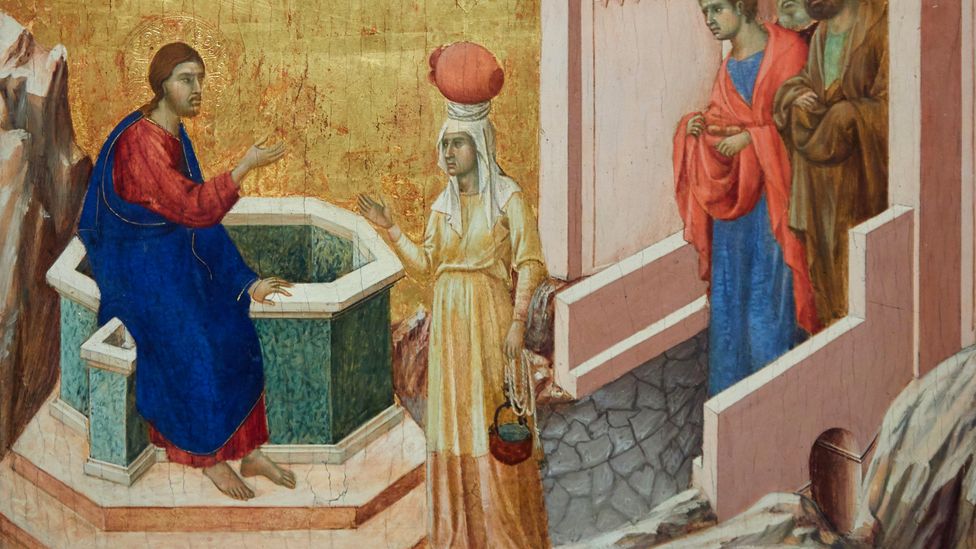
There are many depictions in art of people at wells, such every bit Christ and the Samaritan Adult female (1310-xi) by Duccio di Buoninsegna (Credit: Alamy)
Moreover apocryphal depictions of the New Testament Annunciation (the moment when the Archangel Gabriel informs the Virgin Mary that she will give nascence to Christ) as occurring at the site of a spring were a mainstay among Medieval manuscript illustrators, and may even take inspired the oldest surviving visual portrayal of Mary. An endlessly elastic emblem, equally Walter Pater intimated, Mona Lisa is doubtless capable of arresting all such reflected resonances and many more besides. There is no one she isn't.
Merely possibly the most pertinent parallel between Da Vinci's Mona Lisa and pictorial precursors is one that tin can be drawn with the many representations of a biblical episode in which Jesus finds himself at a well, engaged in cryptic conversation with a adult female from Samaria. In the Gospel of John, Jesus makes a distinction betwixt the water that can be drawn from the natural spring – water which will inevitably leave one "thirsty" – and the "living water" that he can provide. Where h2o from a well can merely sustain a perishable body, 'living water' is capable of quenching the eternal spirit. Notable depictions of the scene by the Medieval Italian painter Duccio di Buoninsegna and by the German language Renaissance master Lucas Cranach the Elder tend to seat Jesus directly on the wall of the well, suggesting his rule over the fleeting elements of this earth. By placing his female sitter notionally inside the well, all the same, Da Vinci confounds the tradition, and suggests instead a merging of textile and spiritual realms – a blurring of the here and futurity – into a shared plane of eternal emergence. In Da Vinci's enthralling narrative, Mona Lisa is herself a miraculous surge of "living h2o", serenely content in the noesis of her own raging infinitude.
If you would similar to comment on this story or anything else yous have seen on BBC Civilisation, caput over to ourFacebook folio or message u.s. onTwitter .
And if you lot liked this story,sign up for the weekly bbc.com features newsletter , chosen The Essential Listing. A handpicked selection of stories from BBC Future, Culture, Worklife and Travel, delivered to your inbox every Fri.
Source: https://www.bbc.com/culture/article/20210211-the-detail-that-unlocks-the-mona-lisa
Posted by: lordtioss1996.blogspot.com


0 Response to "Where Is The Famous "Mona Lisa" Painting Housed?"
Post a Comment